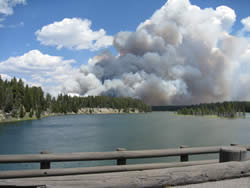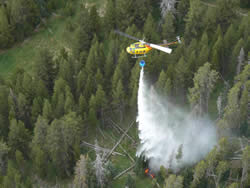Forests and Rangelands Success Story
LeHardy Fire Provides Opportunity for New Policy Implementation
Yellowstone National Park, Wyoming
National Fire Plan - Firefighting
2008

The LeHardy Fire burned actively as viewed from Fishing Bridge in Yellowstone National Park.

A helicopter cools a hotspot on the LeHardy Fire on the east central side of Yellowstone National Park.
When the LeHardy Fire ignited July 30 two miles north of the Fishing Bridge Junction on Park Road 89, firefighters initially aggressively attacked it to protect visitors and a key road during peak visitation. Firefighters continued using a full-perimeter control strategy until the fire crossed the Yellowstone River.
"We continued with full suppression on the west side of the river, but on the east side, there was no way logistically to deal with it," said Joe Krish, Yellowstone National Park fire management officer. "It was really an issue of firefighter safety."
The LeHardy Fire, which was ignited by a tree falling on a power line during a high wind, burned in the Mirror Plateau area on the park’s east central side. Firefighters contained the west flank of the fire August 3, and had it controlled by August 8. Fire managers monitored the east side of the fire, which eventually ran into burned areas from previous wildfires that contained the spread to the north and east. A September 12 map showed the fire at 9,800 acres.
"While our primary reason for not taking aggressive action was firefighter safety, weighing risk versus benefit, there were some benefits realized. This area has not burned in a long time and now we have a large buffer to protect the Fishing Bridge developed area from wildfire," Krish said. "This is also a fire-dependent ecosystem and we have allowed another natural process to fulfill its role."
Yellowstone National Park is a pilot area for implementation of new fire policy guidance scheduled for spring 2009. "Having the ability manage a fire for multiple objectives allowed us to tailor strategies to specific areas of the fire, enhancing firefighter safety, and being cost effective, while protecting the public, public resources and utilizing fire for resource benefits," Krish said.
Yellowstone also used the new Wildfire Decision Support System (WFDSS) to aid in strategy development.
Contact: Joe Krish, Fire Management Officer, (307) 344-2180.